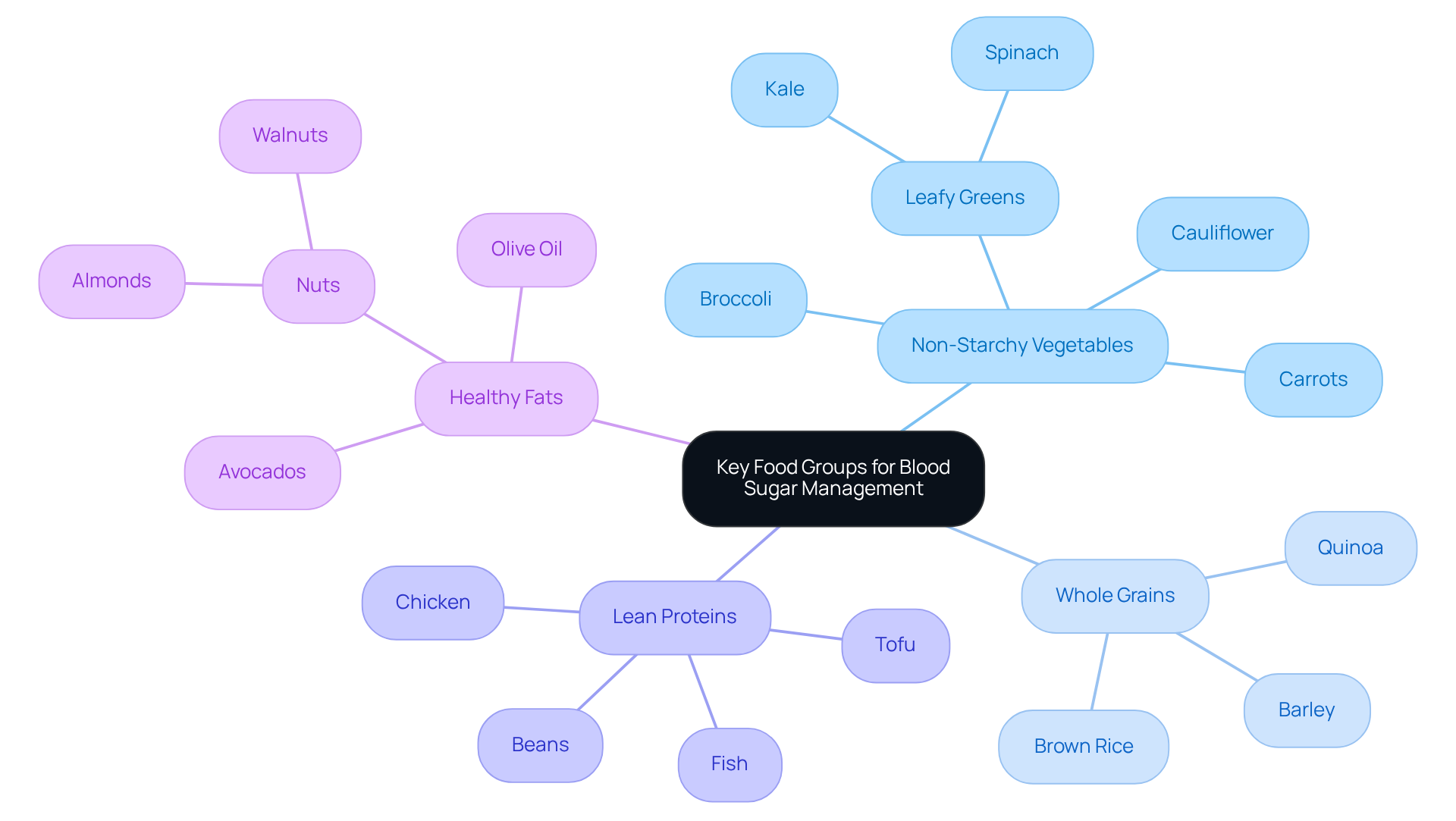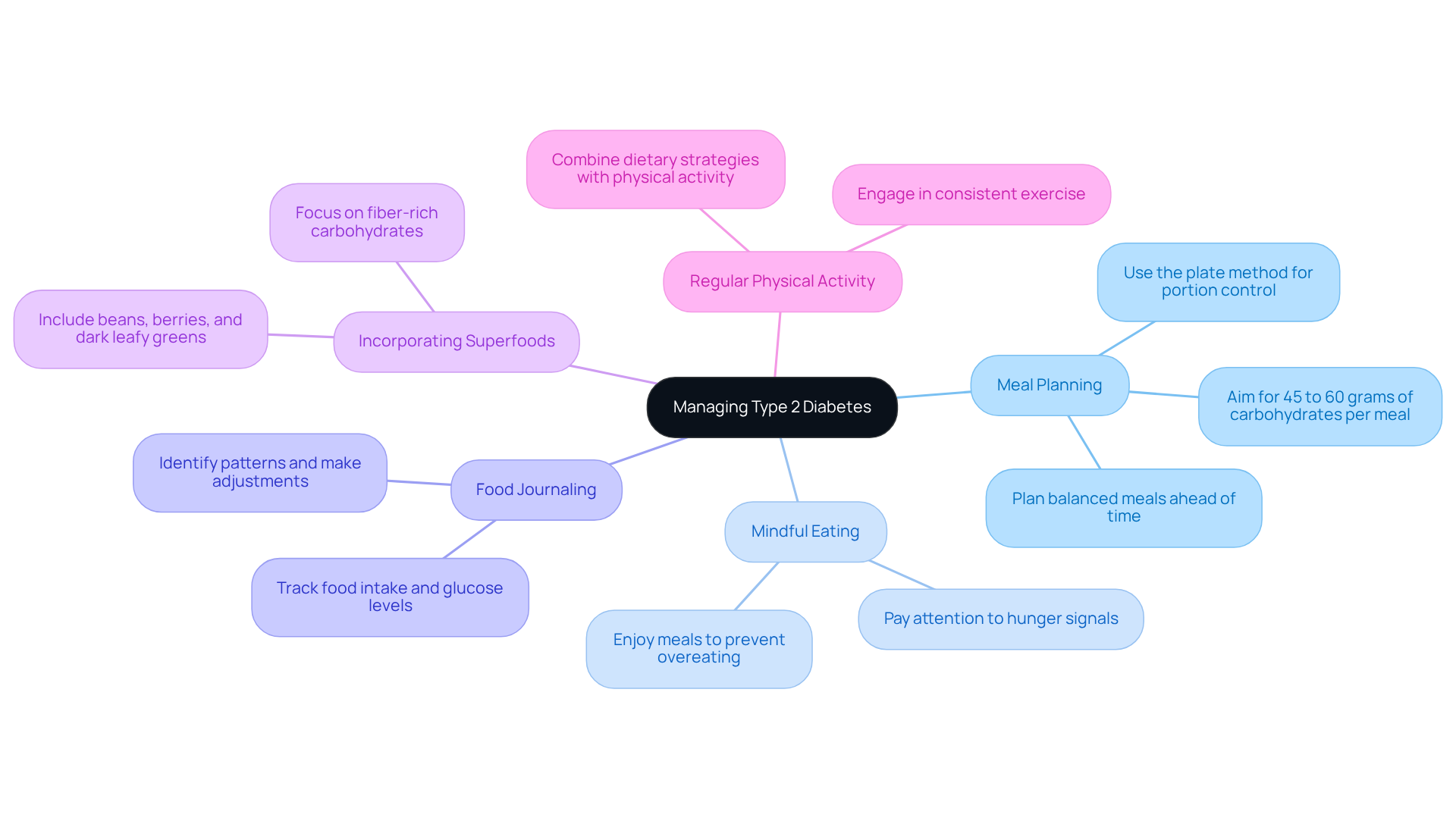Overview
If you have Type 2 Diabetes, know that you can enjoy a balanced diet filled with whole foods. Focus on incorporating:
- Non-starchy vegetables
- Whole grains
- Lean proteins
- Healthy fats
into your meals. It's important to steer clear of refined carbohydrates and saturated fats. These dietary choices are not just about nutrition; they play a vital role in managing your glucose levels and improving your overall health outcomes.
It’s understandable to feel overwhelmed by all this information. Remember, you’re not alone in this journey. Along with these dietary choices, strategies like carbohydrate counting and meal planning can be incredibly helpful. These tools empower you to take control of your health, making it easier to navigate your daily meals with confidence.
As you explore these options, consider reaching out for support or resources that can guide you further. You deserve to feel supported and informed as you make these important changes. Together, we can work toward a healthier future.
Introduction
Understanding the dietary needs of those living with Type 2 Diabetes is crucial for effective management of the condition. With the right food choices, individuals can not only regulate their blood sugar levels but also enhance their overall health and well-being.
It's understandable to feel overwhelmed by the complexities of what to eat. Many wonder: how can one strike the perfect balance between nutrition and enjoyment in their meals?
This article delves into key dietary insights, offering practical strategies and support to empower you on your journey to better health. You're not alone in this journey; we are here to support you every step of the way.
Understanding Dietary Needs for Type 2 Diabetes
If you or someone you care about has been diagnosed with Type 2 Diabetes, it’s important to understand what can people with type 2 diabetes eat to help manage this condition effectively. A balanced diet is essential, particularly in knowing what can people with type 2 diabetes eat, focusing on whole foods that are low in refined sugars and high in fiber. This approach not only supports glucose regulation but also addresses what can people with type 2 diabetes eat to ensure you receive the nutrients your body needs.
Carbohydrate counting is a helpful method to consider, as carbohydrates can significantly impact glucose levels in your body. By understanding what can people with type 2 diabetes eat, you can make informed choices that enhance your health and well-being. Remember, it’s perfectly normal to feel overwhelmed by these changes, but you’re not alone in this journey.
In addition to food choices, monitoring portion sizes and meal timing plays a crucial role in maintaining stable glucose levels. Recent studies highlight the effectiveness of dietary interventions like:
- Intermittent energy restriction (IER)
- Time-restricted eating (TRE)
- Continuous energy restriction (CER)
in improving glucose management and overall health outcomes. The IER approach, in particular, has shown greater benefits in reducing fasting blood glucose and enhancing insulin sensitivity compared to TRE and CER.
By incorporating these strategies into your routine, you can better manage your condition and lower the risk of complications related to Type 2 Diabetes. Remember, we are here to support you every step of the way as you navigate this journey toward better health.

Key Food Groups and Their Impact on Blood Sugar
Managing Type 2 Diabetes can feel overwhelming, but understanding what can people with type 2 diabetes eat can significantly aid your journey. Non-starchy vegetables, such as leafy greens and broccoli, should fill half of your plate. These foods are low in calories and carbohydrates, making them perfect for helping regulate your glucose levels. Rich in essential nutrients and fiber, they can stabilize your glucose levels and support your overall health.
Whole grains, like quinoa and brown rice, are equally important. They provide fiber that not only helps regulate glucose levels but also enhances feelings of fullness. Nutritionists emphasize that incorporating whole grains into your meals can greatly impact your glucose regulation, offering energy at a slower rate compared to processed grains.
Lean proteins, including chicken, fish, and plant-based options like tofu, are vital for muscle health without causing spikes in glucose. Additionally, healthy fats found in avocados and nuts contribute to satiety and cardiovascular wellness, making them valuable additions to your meals.
However, it’s essential to be mindful of foods rich in refined carbohydrates and saturated fats, as these can lead to rapid increases in glucose levels, complicating diabetes management. Striving for a balanced plate that emphasizes what can people with type 2 diabetes eat can help you make informed dietary choices that enhance your health. Remember, you're not alone in this journey; seeking support and resources can provide you with the guidance you need to thrive.

Practical Dietary Strategies for Managing Type 2 Diabetes
Managing Type 2 Diabetes can feel overwhelming, but knowing what can people with type 2 diabetes eat can provide practical dietary approaches that make a significant difference. Meal planning is one such strategy. By preparing balanced meals ahead of time, you can reduce the likelihood of making impulsive, unhealthy choices. Aim for 45 to 60 grams of carbohydrates at each meal to help maintain stable blood sugar levels.
It's also important to practice mindful eating. This means paying attention to your hunger signals and truly enjoying your meals, which can prevent overeating and increase your satisfaction. As registered dietitian Barbie Cervoni wisely notes, 'An individualized approach to eating that considers a person's nutritional needs, meal preferences, culture, and lifestyle is essential for understanding what can people with type 2 diabetes eat.'
Keeping a food journal can be incredibly beneficial as well. It allows you to monitor what you eat and how it affects your glucose levels, helping you identify patterns and make necessary adjustments. To enhance your dietary choices, consider incorporating superfoods like beans, berries, and dark leafy greens, which are great options when thinking about what can people with type 2 diabetes eat, as recommended by the American Diabetes Association.
Additionally, integrating regular physical activity with these dietary strategies can significantly improve blood sugar control, leading to better overall health outcomes. Remember, you're not alone in this journey. By adopting these practical approaches, you can take proactive steps toward effective diabetes management.
Here are some key points to consider:
- Plan your meals to avoid impulsive choices.
- Practice mindful eating to enjoy your food and prevent overeating.
- Keep a food journal to track your intake and its effects.
- Incorporate superfoods to boost your nutrition.
- Engage in regular physical activity to support your health.
We are here to support you every step of the way.

The Role of Community Support in Dietary Management
Community support plays a vital role in managing Type 2 Diabetes. It's understandable to feel overwhelmed, but participating in support groups—whether face-to-face or online—can be a comforting way to exchange experiences, recipes, and strategies for managing what can people with type 2 diabetes eat. These interactions foster a sense of belonging and significantly reduce feelings of isolation.
Moreover, community initiatives that emphasize nutrition education and cooking classes provide practical skills and knowledge about what can people with type 2 diabetes eat. This empowers individuals to make healthier choices. By building a supportive network, you can enhance your motivation and commitment to maintaining a healthy diet. Remember, you're not alone in this journey; there are resources available to help you every step of the way.
Conclusion
Understanding what individuals with Type 2 Diabetes can eat is crucial for effectively managing this condition. A well-rounded diet centered on whole foods, low in refined sugars and high in fiber, not only aids in glucose regulation but also ensures the body receives essential nutrients. By embracing these dietary principles, individuals can take significant steps towards improving their health and well-being.
Throughout this article, we have shared key insights, including:
- The importance of carbohydrate counting
- Portion control
- Meal timing
Emphasizing non-starchy vegetables, whole grains, lean proteins, and healthy fats can greatly impact blood sugar management. Additionally, practical strategies such as:
- Meal planning
- Mindful eating
- Community support
have been highlighted as vital components of a successful dietary approach for those living with Type 2 Diabetes.
Ultimately, taking proactive steps toward dietary management can lead to better health outcomes and a higher quality of life. You're not alone in this journey; engaging with support networks, seeking educational resources, and implementing effective meal planning strategies can empower you on your path. The road to managing Type 2 Diabetes may seem daunting, but with the right knowledge and support, it becomes a manageable and rewarding endeavor. We are here to support you every step of the way.
Frequently Asked Questions
What dietary changes should people with Type 2 Diabetes consider?
People with Type 2 Diabetes should focus on a balanced diet that includes whole foods low in refined sugars and high in fiber to support glucose regulation and overall nutrient intake.
How does carbohydrate counting help in managing Type 2 Diabetes?
Carbohydrate counting is a helpful method because carbohydrates significantly impact glucose levels. By understanding carbohydrate content, individuals can make informed food choices that enhance their health.
What role do portion sizes and meal timing play in diabetes management?
Monitoring portion sizes and meal timing is crucial for maintaining stable glucose levels, which can help manage Type 2 Diabetes effectively.
What dietary interventions are effective for improving glucose management?
Effective dietary interventions include Intermittent Energy Restriction (IER), Time-Restricted Eating (TRE), and Continuous Energy Restriction (CER). Among these, IER has shown greater benefits in reducing fasting blood glucose and enhancing insulin sensitivity.
What are the benefits of the Intermittent Energy Restriction (IER) approach?
The IER approach has been shown to provide greater benefits in improving fasting blood glucose levels and enhancing insulin sensitivity compared to other methods like TRE and CER.
How can individuals with Type 2 Diabetes find support while making dietary changes?
It’s important to remember that feeling overwhelmed by dietary changes is normal, and support is available to help individuals navigate their journey toward better health.



